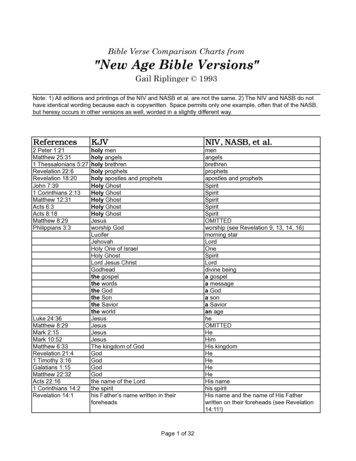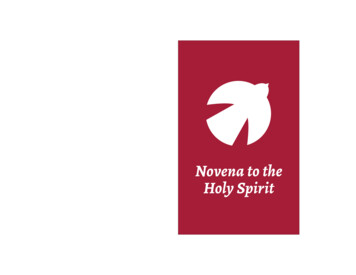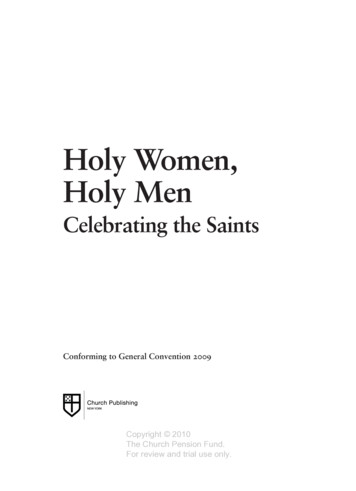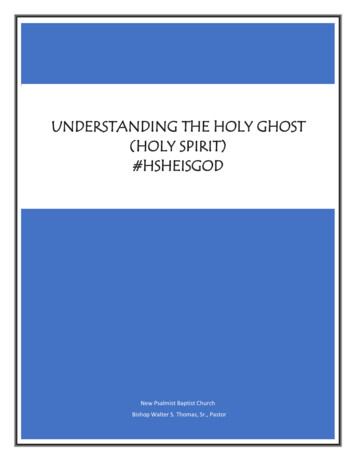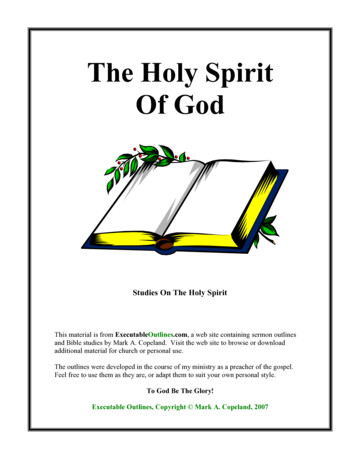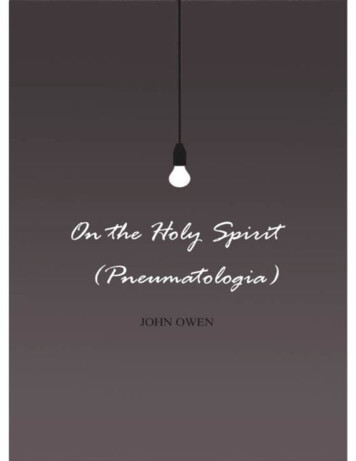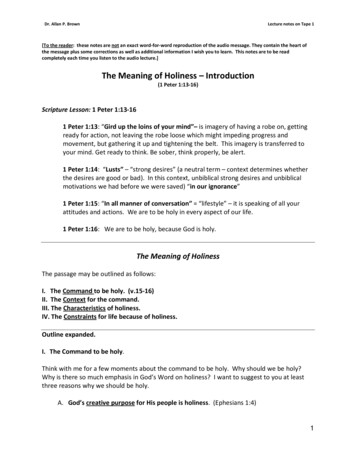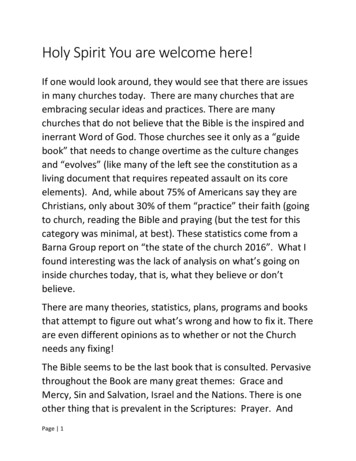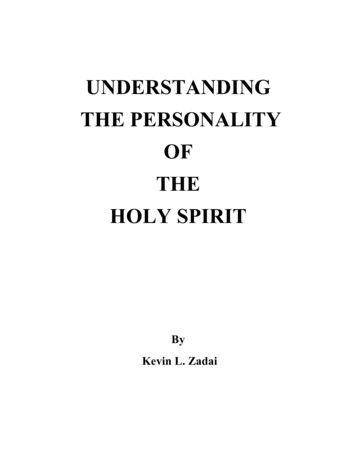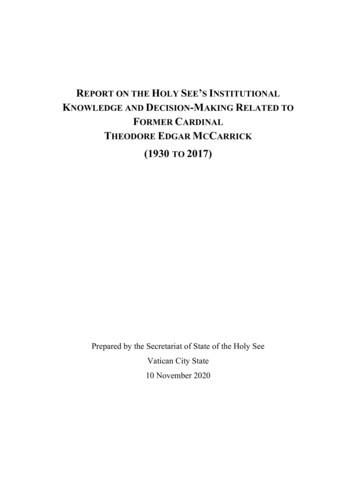
Transcription
REPORT ON THE HOLY SEE’S INSTITUTIONALKNOWLEDGE AND DECISION-MAKING RELATED TOFORMER CARDINALTHEODORE EDGAR MCCARRICK(1930 TO 2017)Prepared by the Secretariat of State of the Holy SeeVatican City State10 November 2020
Copyright 2020 Holy See – Secretariat of State. All rights reserved.Reproduction in part is permitted exclusively for the exercise of the right to report.
Copyright 2020 Holy See – Secretariat of State. All rights reserved.Reproduction in part is permitted exclusively for the exercise of the right to report.
Published without waiver of privileges or immunities and with a fullreservation of intellectual property and other rights.Copyright 2020 Holy See – Secretariat of State. All rights reserved.Reproduction in part is permitted exclusively for the exercise of the right to report.
Copyright 2020 Holy See – Secretariat of State. All rights reserved.Reproduction in part is permitted exclusively for the exercise of the right to report.
TABLE OF CONTENTSI.INTRODUCTION . 1A.Scope and Nature of the Report Related toFormer Cardinal Theodore Edgar McCarrick. 1B.Executive Summary . 51.Knowledge and Decision-Making Relatedto McCarrick During the Papacy of PaulVI . 52.Knowledge and Decision-Making Relatedto McCarrick During the Papacy of JohnPaul II . 5a.Appointments to Metuchen andNewark. 5b.Appointment to Washington. 63.Knowledge and Decision-Making Relatedto McCarrick During the Papacy ofBenedict XVI . 104.Knowledge and Decision-Making Relatedto McCarrick During the Papacy ofFrancis . 12II.BACKGROUND (1930 TO 1976). 15III.ELEVATION TO THE EPISCOPATE (1968 TO 1977) . 21IV.APPOINTMENT AS BISHOP OF METUCHEN (1981) . 27V.TENURE AS BISHOP OF METUCHEN (1982 TO 1986) . 29VI.ANONYMOUS ALLEGATION DURING TENURE AS BISHOP OFMETUCHEN (MID-1980S) . 37VII. APPOINTMENT AS ARCHBISHOP OF NEWARK (1986) . 49Copyright 2020 Holy See – Secretariat of State. All rights reserved.Reproduction in part is permitted exclusively for the exercise of the right to report.i
VIII. TENURE AS ARCHBISHOP OF NEWARK (1986 TO 2000) . 51IX.X.XI.BISHOP HUGHES, BISHOP SMITH AND BISHOP MCHUGH’SKNOWLEDGE OF MCCARRICK’S MISCONDUCT. 67A.Information Received by Bishop Hughes fromPriest 4 (1989) . 67B.Information Received by Bishop Hughes fromPriest 1 (1993 to 1996). 77C.Information Received by Bishop Hughes fromPriest 3 (1994) . 82D.Incident at a Newark Catering Hall (January1990) . 87ALLEGATIONS AGAINST MCCARRICK DURING HIS TENUREAS ARCHBISHOP OF NEWARK (1992 TO 1997) . 95A.Anonymous and Pseudonymous Letters (1992 to1993) . 95B.Cardinal O’Connor’s “Verification” andInformation Received Prior to the Papal Visit(Late 1993 to 1995). 111C.Information Received from Cardinal O’Connorand Dr. Richard Fitzgibbons (1996 to 1997) . 117CANDIDACY FOR THE ARCHBISHOPRIC OF CHICAGO (1997) . 125XII. CANDIDACY FOR THE ARCHBISHOPRIC OF NEW YORK(MID-1999 TO EARLY 2000) . 129XIII. NUNCIO MONTALVO’S INVESTIGATION OF ALLEGATIONSAGAINST MCCARRICK (MAY TO JUNE 2000) . 147XIV. EPISCOPAL ENDORSEMENTS FOR MCCARRICK’S TRANSFERTO WASHINGTON (MAY TO JULY 2000) . 163XV. POPE JOHN PAUL II’S INITIAL DECISION AGAINST THETRANSFER OF MCCARRICK TO WASHINGTON (JULY 2000) . 165Copyright 2020 Holy See – Secretariat of State. All rights reserved.Reproduction in part is permitted exclusively for the exercise of the right to report.ii
XVI. MCCARRICK’S LETTER TO BISHOP DZIWISZ AND POPEJOHN PAUL II’S DECISION TO TRANSFER MCCARRICK TOWASHINGTON (AUGUST TO NOVEMBER 2000) . 169XVII.ADDITIONAL INFORMATION RECEIVED BY NUNCIOMONTALVO FOLLOWING ANNOUNCEMENT OFMCCARRICK’S APPOINTMENT TO WASHINGTON (LATE2000 TO EARLY 2001) . 185XVIII. TENURE AS ARCHBISHOP OF WASHINGTON (2001 TO2006) . 193XIX. INFORMATION ABOUT MCCARRICK’S PAST CONDUCTRECEIVED DURING HIS TENURE AS ARCHBISHOP OFWASHINGTON (2001 TO 2006) . 211A.Information Received Early During McCarrick’sTenure in Washington (2001 to 2002) . 211B.McCarrick’s Public Revelation of a PriorAnonymous Accusation and Journalists’Investigations Regarding the Beach House(April to May 2002) . 214C.Information Received by the Apostolic NuncioRelated to Priest 2 (2004 to 2005) . 225D.Information Received Related to Priest 1 andMcCarrick’s Resignation as Archbishop ofWashington (2005 to 2006) . 229XX. PRIEST 1’S INCIDENT REPORT AND VERBAL INDICATIONSGIVEN TO MCCARRICK (2006) . 249XXI. HOLY SEE DECISION-MAKING AND MCCARRICK’SACTIVITY FOLLOWING PREFECT RE’S VERBALINDICATIONS (2007 TO MID-2008). 271XXII. HOLY SEE DECISION-MAKING AND MCCARRICK’SACTIVITY FOLLOWING POPE BENEDICT XVI’S TRIP TO THEUNITED STATES AND PREFECT RE’S 14 JUNE 2008 LETTERTO MCCARRICK (MID-2008 TO EARLY 2009) . 279Copyright 2020 Holy See – Secretariat of State. All rights reserved.Reproduction in part is permitted exclusively for the exercise of the right to report.iii
A.Richard Sipe’s Open Letter to Pope BenedictXVI, Archbishop Viganò’s Memorandum andNuncio Sambi’s Report (April to May 2008) . 279B.Cardinal Re’s Written Indications to McCarrick(June to August 2008) . 295C.McCarrick’s Responses to the WrittenIndications and Related Holy See DecisionMaking (August 2008 to June 2009) . 302XXIII.MCCARRICK’S CONTINUED ACTIVITY AND RELATEDHOLY SEE DECISION-MAKING (FALL 2008 TO FALL2011) . 345XXIV.MCCARRICK’S ACTIVITY AND HOLY SEE DECISIONMAKING DURING THE FIRST EIGHTEEN MONTHS OFARCHBISHOP VIGANÒ’S TENURE AS APOSTOLICNUNCIO (FALL 2011 TO SPRING 2013) . 367A.McCarrick’s Continued Activity DuringArchbishop Viganò’s Tenure as ApostolicNuncio (Fall 2011 to Fall 2012) . 367B.Information Received by Nuncio Viganò fromPriest 3 and Cardinal Ouellet’s Instructions toViganò (August to November 2012) . 378C.McCarrick’s Activity During the Transition fromPope Benedict XVI to Pope Francis (February toMarch 2013) . 389XXV.KNOWLEDGE OF PRIOR ALLEGATIONS ANDMCCARRICK’S ACTIVITY DURING THE PAPACY OFFRANCIS (SPRING 2013 TO SPRING 2017). 393A.Knowledge of Prior Allegations and IndicationsDuring the Early Papacy of Francis (Spring toFall 2013) . 393B.Holy See Decision-Making and McCarrick’sActivity During the Papacy of Francis (Spring2013 to Early 2017) . 408Copyright 2020 Holy See – Secretariat of State. All rights reserved.Reproduction in part is permitted exclusively for the exercise of the right to report.iv
XXVI.ACCUSATION IN THE ARCHDIOCESE OF NEW YORK ANDMCCARRICK’S RESIGNATION FROM THE COLLEGE OFCARDINALS (MID-2017 TO MID-2018) . 433XXVII. NEW ACCUSATIONS, CDF ADMINISTRATIVEPROCEEDING, AND MCCARRICK’S DISMISSAL FROMTHE CLERICAL STATE (MID-2018 TO EARLY 2019) . 437XXVIII. INFORMATION RECEIVED FROM MINORS, MEMBERS OFCERTAIN NEW YORK FAMILIES AND FORMERSEMINARIANS AND PRIESTS (2019 TO 2020) . 439XXIX.XXX.INFORMATION RECEIVED FROM CATHOLIC ENTITIES(2018 TO 2020) . 443A.United States Conference of Catholic Bishops. 443B.Archdiocese of New York . 443C.Archdiocese of Newark . 445D.Seton Hall University. 445E.Diocese of Metuchen . 447F.Archdiocese of Washington . 447CONCLUSION . 449Copyright 2020 Holy See – Secretariat of State. All rights reserved.Reproduction in part is permitted exclusively for the exercise of the right to report.v
Copyright 2020 Holy See – Secretariat of State. All rights reserved.Reproduction in part is permitted exclusively for the exercise of the right to report.
I.INTRODUCTIONA.Scope and Nature of the Report Related to Former CardinalTheodore Edgar McCarrickOn 6 October 2018, the Holy Father ordered a thorough study of thedocumentation present in the Archives of the Dicasteries and Offices of theHoly See regarding McCarrick, in order to ascertain all the relevant facts, toplace them in their historical context and to evaluate them objectively.The examination of documents was undertaken in compliance with theinstructions of the Holy Father and under the auspices of the Secretariat ofState. No limit was placed on the examination of documents, the questioningof individuals or the expenditure of resources necessary to carry out theinvestigation. The Secretariat of State, having now concluded itsexamination, sets forth the results in this Report on the Holy See’sInstitutional Knowledge and Decision-Making Related to Former CardinalTheodore Edgar McCarrick (1930 to 2017) (“Report”). The Report isreleased to the public pursuant to the Holy Father’s instruction in thisexceptional case for the good of the Universal Church.This Report is based upon review of all relevant documents located after adiligent search. Within the Roman Curia, information was primarily obtainedfrom the Secretariat of State, the Congregation for Bishops, theCongregation for the Doctrine of the Faith, the Congregation for Clergy andthe Congregation for Divine Worship and the Discipline of the Sacraments.All relevant documents of the Apostolic Nunciature to the United States werealso examined. While an explanation of the various roles and functions ofthe named dicasteries and officials is beyond the scope of the Report, anunderstanding of such matters, including the distinctions between thecompetencies of the dicasteries, is critical to comprehend the decisionmaking process described below.Although the Holy See’s examination was originally focused on documents,information was also gathered through over ninety witness interviews, eachranging in length from one to thirty hours. The interviewees included currentand former Holy See officials; cardinals and bishops in the United States;Copyright 2020 Holy See – Secretariat of State. All rights reserved.Reproduction in part is permitted exclusively for the exercise of the right to report.1
officers of the United States Conference of Catholic Bishops (USCCB);former seminarians and priests from various dioceses; several ofMcCarrick’s secretaries from Metuchen, Newark and Washington; and laypeople in the United States, Italy and elsewhere. Unless otherwise indicated,the interviews referred to in the Report took place between May 2019 andOctober 2020.The Holy See’s examination included review of statements and otherdocuments received from individual participants in the interview process, aswell as review of the testimony collected during the administrative penalprocedure conducted by the Congregation for the Doctrine of the Faith inlate 2018 and early 2019. The Holy See also received materials fromCatholic entities in the United States, including the USCCB, the Diocese ofMetuchen, the Archdiocese of Newark, the Archdiocese of New York, theArchdiocese of Washington and Seton Hall University.1 The materials weregathered for the sole purpose of contributing to this Report and are notauthorized for any other use.Consistent with instructions, the Report describes the Holy See’sinstitutional knowledge and decision-making related to McCarrick, as placedin historical context. As emerged over the course of the examination, therelevant context includes McCarrick’s activities, accomplishments andtravels, which all bore upon Holy See decision-making. The knowledge andactions of individuals and institutions in the United States are likewisediscussed to the extent that they are relevant to the Holy See’s decisions.This Report does not examine the issue of McCarrick’s culpability undercanon law, since that question has already been adjudicated by theCongregation for the Doctrine of the Faith. While the Secretariat of State’sexamination was not focused on discovering the precise nature ofMcCarrick’s misconduct, numerous individuals who had direct physicalcontact with McCarrick were interviewed in connection with the Report.2During extended interviews, often emotional, the persons described a range1Section XXIX.2Section XXVIII.Copyright 2020 Holy See – Secretariat of State. All rights reserved.Reproduction in part is permitted exclusively for the exercise of the right to report.2
of behavior, including sexual abuse or assault, unwanted sexual activity,intimate physical contact and the sharing of beds without physical touching.The interviews also included detailed accounts related to McCarrick’s abuseof authority and power. The individuals’ full accounts, which provedextraordinarily helpful to the examination, were carefully reviewed, weremade available to Pope Francis and are preserved in the Holy See’s archives.Because this Report is focused on institutional knowledge and decisionmaking related to McCarrick, only the accounts that were known to HolySee officials or to members of the ecclesiastical hierarchy in the UnitedStates before late 2017 are set forth in the Report, with victims’ consent andapproval. Any person who was victimized by McCarrick of course remainsfree to share his experiences publicly, as several have already done. Forreaders who have suffered from sexual abuse or sexual harassment, thesections of the Report that recount incidents involving McCarrick, includingSections VI, IX, X.C, XIX.D, XX and XXVIII, could prove traumatizing andshould be approached with caution. Some sections of this Report are alsoinappropriate for minors.With respect to his international activities, McCarrick worked on behalf ofmany different religious and secular entities over the course of five decades.McCarrick traveled abroad for the USCCB, Catholic Relief Services, theHoly See, the United States Department of State, the Appeal of ConscienceFoundation, and a range of other private and governmental entities andindividuals. McCarrick also engaged in initiatives and traveled of his ownaccord.Regarding international work coordinated with the Holy See, McCarrick’sactivities often constituted a form of “soft diplomacy,” based upon pastoralwork and cultural, educational, scientific and inter-religious dialogue.McCarrick was never a diplomatic agent of the Holy See. Although theinternational relations of the Holy See occasionally provide importantcontext for McCarrick’s activities, this Report avoids setting forth detailedinformation implicating foreign affairs, particularly as to ongoing or delicatematters.Copyright 2020 Holy See – Secretariat of State. All rights reserved.Reproduction in part is permitted exclusively for the exercise of the right to report.3
While McCarrick’s fundraising and gift-giving are discussed below, theReport does not provide an accounting of such activities, which took placeover at least four decades. Overall, the record appears to show that althoughMcCarrick’s fundraising skills were weighed heavily, they were notdeterminative with respect to major decisions made relating to McCarrick,including his appointment to Washington in 2000. In addition, theexamination did not reveal evidence that McCarrick’s customary gift-givingand donations impacted significant decisions made by the Holy Seeregarding McCarrick during any period.The citations set forth in the footnotes below refer to the Acta deposited inHoly See archives with the original of the Report. To protect the rights andinterests of individuals and public and private entities involved, the Acta arenot published with this Report. Nevertheless, the Report quotes criticaldocuments in full. With respect to documents described or quoted in part,those descriptions and quotations accurately reflect the content of thedocument at issue. Emphasis in the quoted documents appears in the originalunless otherwise indicated.Preparation of the Report required extensive translation of documents,primarily from English to Italian and vice versa. With the notable exceptionof correspondence sent directly to McCarrick, most of the key documentsfrom the Roman Curia and the Apostolic Nunciature were written in Italian,whereas most of the documents from the United States were written inEnglish. Italian language documents are indicated by an asterisk when firstcited. The source language of any given document is authoritative as to itsmeaning.Although the passage of time and the complexity of the matter make itimpossible to include all information, this Report should provide asignificant contribution to the record. As Marc Cardinal Ouellet, the Prefectof the Congregation for Bishops, wrote in an open letter on 7 October 2018,“I hope like many others, out of respect for the victims and the need forjustice, that the investigation . . . in the United States and in the Roman Curiawill finally offer us a critical, comprehensive view on the procedures and theCopyright 2020 Holy See – Secretariat of State. All rights reserved.Reproduction in part is permitted exclusively for the exercise of the right to report.4
circumstances of this painful case, so that such events are not repeated in thefuture.”3B.Executive SummaryThis section summarizes the key facts and decision-making regarding formerCardinal McCarrick, from his elevation to the episcopate in 1977 throughthe allegation in 2017 that he had sexually abused a minor during the early1970s. To assist the reader, the summary references relevant sections of theReport for each topic.1.Knowledge and Decision-Making Related toMcCarrick During the Papacy of Paul VIFollowing an extensive examination of McCarrick’s background, Pope PaulVI appointed Monsignor Theodore McCarrick Auxiliary Bishop in NewYork in 1977. Most informants consulted during the nomination processstrongly recommended McCarrick for elevation to the episcopate. No onereported having witnessed or heard of McCarrick engaging in any improperbehavior, either with adults or minors.42.Knowledge and Decision-Making Related toMcCarrick During the Papacy of John Paul IIa.Appointments to Metuchen and NewarkPope John Paul II appointed McCarrick as Bishop of Metuchen (1981) andArchbishop of Newark (1986). The decisions to appoint McCarrick werebased upon his background, skills, and achievements. During theappointment process, McCarrick was widely lauded as a pastoral, intelligentand zealous bishop, and no credible information emerged suggesting that hehad engaged in any misconduct.5317 ACTA 14815.4Sections II and III.5Sections IV and VII; see also Section VI.Copyright 2020 Holy See – Secretariat of State. All rights reserved.Reproduction in part is permitted exclusively for the exercise of the right to report.5
In Metuchen and Newark, McCarrick was recognized as a hard worker,active in the Episcopal Conference and on the national and internationalstage. He also became known and appreciated as an effective fundraiser, bothat the diocesan level and for the Holy See.6b.Appointment to WashingtonArchbishop McCarrick was appointed to Washington in late 2000 andcreated cardinal in early 2001. The evidence shows that Pope John Paul IIpersonally made the decision to appoint McCarrick and did so after receivingthe counsel of several trusted advisors on both sides of the Atlantic.At the time of his appointment to Washington, the allegations againstMcCarrick generally fell into four categories:(1) Priest 1, formerly of the Diocese of Metuchen, claimed that he hadobserved McCarrick’s sexual conduct with another priest in June1987, and that McCarrick attempted to engage in sexual activity withPriest 1 later that summer;7(2) a series of anonymous letters, sent to the National Conference ofCatholic Bishops, the Apostolic Nuncio and various cardinals in theUnited States in 1992 and 1993, accused McCarrick of pedophiliawith his “nephews”;8(3) McCarrick was known to have shared a bed with young adult menin the Bishop’s residence in Metuchen and Newark;9 and6Sections V and VIII.7Sections X.C, XII and XIII. With regard to persons identified in this Report with anumbered pseudonym to protect their privacy, the Secretariat of State is aware of theirtrue identities.8Sections X.A, XII and XIII.9Sections XII and XIII.Copyright 2020 Holy See – Secretariat of State. All rights reserved.Reproduction in part is permitted exclusively for the exercise of the right to report.6
(4) McCarrick was known to have shared a bed with adult seminariansat a beach house on the New Jersey shore.10These allegations were generally summarized in a 28 October 1999 letterfrom Cardinal O’Connor, the Archbishop of New York, to the ApostolicNuncio, and were shared with Pope John Paul II shortly thereafter.11Information regarding McCarrick’s conduct led to the conclusion that itwould be imprudent to transfer him from Newark to another See on threeoccasions, namely Chicago (in 1997),12 New York (1999/2000)13 and,initially, Washington (July 2000).14 However, Pope John Paul II seems tohave changed his mind in August/September 2000, ultimately leading to hisdecision to appoint McCarrick to Washington in November 2000.15 Themain reasons for the change in John Paul II’s thinking appear to have beenas follows: At the request of Pope John Paul II, in May to June 2000, ArchbishopMontalvo, the Nuncio to the United States, conducted a writteninquiry directed at four New Jersey bishops to determine whether theallegations against McCarrick were true. The bishops’ responses tothe inquiry confirmed that McCarrick had shared a bed with youngmen but did not indicate with certainty that McCarrick had engaged inany sexual misconduct.16 What is now known, through investigationundertaken for the preparation of the Report, is that three of the fourAmerican bishops provided inaccurate and incomplete information tothe Holy See regarding McCarrick’s sexual conduct with young10Sections XII and XIII.11Section XII.12Section XI.13Section XII.14Sections XIII, XIV and XV.15Section XVI.16Section XIII.Copyright 2020 Holy See – Secretariat of State. All rights reserved.Reproduction in part is permitted exclusively for the exercise of the right to report.7
adults.17 This inaccurate information appears likely to have impactedthe conclusions of John Paul II’s advisors and, consequently, of JohnPaul II himself.18 On 6 August 2000, McCarrick wrote a letter to Bishop Dziwisz, thePope’s particular secretary, which was intended to rebut theallegations made by Cardinal O’Connor. In the letter, which wasprovided to Pope John Paul II, McCarrick affirmed: “In the seventyyears of my life, I have never had sexual relations with any person,male or female, young or old, cleric or lay, nor have I ever abusedanother person or treated them with disrespect.” McCarrick’s denialwas believed and the view was held that, if allegations againstMcCarrick were made public, McCarrick would be able to refute themeasily.19 At the time of McCarrick’s appointment, and in part because of thelimited nature of the Holy See’s own prior investigations, the HolySee had never received a complaint directly from a victim, whetheradult or minor, about McCarrick’s misconduct.20 For this reason,McCarrick’s supporters could plausibly characterize the allegationsagainst him as “gossip” or “rumors.”21 Priest 1, the only individual at the time to claim sexual misconduct byMcCarrick, was treated as an unreliable informant, in part because hehimself had previously abused two teenage boys.22 In addition, the17Section IX.18Sections XII, XIII, XV and XVI.19Section XVI.20Sections XII and XIII.21Sections XII, XIII and XV.22Sections XII and XIII.Copyright 2020 Holy See – Secretariat of State. All rights reserved.Reproduction in part is permitted exclusively for the exercise of the right to report.8
Holy See did not receive any signed statement from Priest 1 regardinghis allegations against McCarrick.23 Although McCarrick admitted that his sharing of a bed withseminarians at the beach house was “imprudent,” he insisted that hehad never engaged in sexual conduct and that claims to the contrary,including the anonymous letters, constituted calumnious and/orpolitically motivated gossip.24 Though there is no direct evidence, itappears likely from the information obtained that John Paul II’s pastexperience in Poland regarding the use of spurious allegations againstbishops to degrade the standing of the Church played a role in hiswillingness to believe McCarrick’s denials.25 Over two decades of episcopal ministry, McCarrick was recognizedas an exceptionally hard-working and effective bishop able to handledelicate and difficult assignments both in the United States and insome of the most sensitive parts of the world – including in the formerEastern Bloc and particularly Yugoslavia.26 Pope John Paul II had known McCarrick for years, having first methim in the mid-1970s.27 McCarrick interacted with the Popefrequently, both in Rome and during trips overseas, including at thetime of the Pope’s visit to Newark in 1995 and during annual trips toRome for the Papal Foundation.28 McCarrick’s direct relationship withJohn Paul II also likely had an impact on the Pope’s decision-making.23Sections X.C, XII, and XIII.24Section XVI.25Section XVI.26Sections V and VIII.27Sections II and III.28Sections V and VIII.Copyright 2020 Holy See – Secretariat of State. All rights reserved.Reproduction in part is permitted exclusively for the exercise of the right to report.9
3.Knowledge and Decision-Making Related toMcCarrick During the Papacy of Benedict XVIAt the beginning of the papacy of Benedict XVI, the information receivedby the Holy See related to McCarrick’s misconduct was generally similar tothe information that had been available to John Paul II at the time of theappointment to Washington.29 Shortly after his election in April 2005, uponthe recommendation of the Nuncio and the Congregation for Bishops, PopeBenedict XVI extended McCarrick’s tenure in Washington, which wasviewed as successful, by two years.30Based upon new details related to Priest 1’s allegations, the Holy Seereversed course in late 2005 and urgently sought a successor for theArchbishopric of Washington, requesting that McCarrick “spontaneously”withdraw as Archbishop after Easter 2006.31Over the next two years, Holy See officials wrestled with how to addressissues regarding Cardinal McCarrick. While serving in the Secretariat ofState, Archbishop Viganò wrote two memoranda, one in 2006 and the otherin 2008, for the purpose of bringing questions related to McCarrick to theattention of Superiors.32 The memoranda referred to the allegations andrumors about McCarrick’s misconduct during the 1980s and raised concernsthat a scandal could result given that the information had already circulatedwidely. Noting that the allegations remained unproven (“Si vera et probatasunt exposita”) and recognizing that only the Pope could judge a cardinalunder the canon law, Viganò suggested that a canonical process could beopened to determine the truth and, if warranted, to impose an “exemplarymeasure.”Viganò’s Superiors, Secretary of State Cardinal Bertone and SubstituteArchbishop Sandri, shared Viganò’s concerns and Cardinal Bertone29Sections XIX.A, XIX.B and XIX.C.30Sections XVIII and XIX.D.31Section XIX.D.32Sections XX and XXII.A.Copyright 2020 Holy See – Secretariat of State. All rights reserved.Reproduction in part is permitted exclusively for the exercise of the right to report.10
presented the matter directly to Pope Benedict XVI. Ultimately, the path ofa canonical process to resolve factual issues and possibly prescribe canonicalpenalties was not taken.33 Instead, the decision was made to appeal toMcCarrick’s conscience and ecclesial spirit by indicating to him that heshould maintain a lower profile and minimize travel for the good of theChurch. In 2006, Cardinal Re, Prefect of the Congregation for Bishops,instructed Nuncio Sambi to convey these
examination, sets forth the results in this Report on the Holy See's Institutional Knowledge and Decision-Making Related to Former Cardinal Theodore Edgar McCarrick (1930 to 2017) ("Report"). The Report is released to the public pursuant to the Holy Father's instruction in this exceptional case for the good of the Universal Church.

